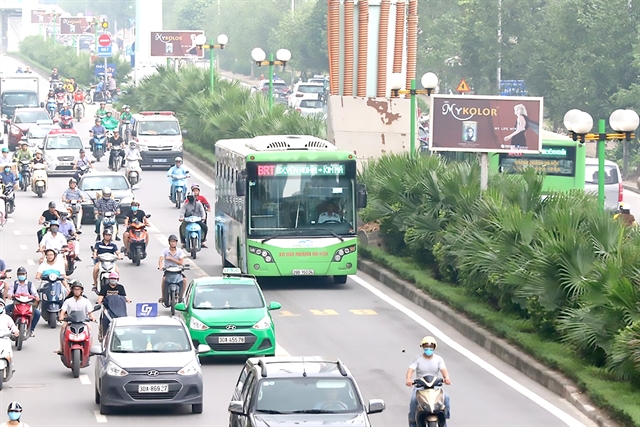 Society
Society

 |
| The BRT bus traveling on BRT01 route, from Kim Mã to Yên Nghĩa Station in Hà Đông, Hà Nội. — Photo tienphong.vn |
HÀ NỘI — In a bid to meet 40-60 per cent of the citizens' travel needs, the Hà Nội People's Committee is intensifying efforts to develop public passenger transport. Alongside the ten planned and ongoing routes, the committee has proposed the addition of six more urban railway lines. Notably, one of these lines is intended to replace the BRT fast bus along the Lê Văn Lương route (Route 01 BRT Kim Mã - Hà Đông).
Urban Railway Planning to Replace BRT
To finalise the adjustments to the general planning of Hà Nội's capital after 12 years of implementation, the Hà Nội People's Committee is seeking input from 30 districts, towns and representatives from eight provinces and cities bordering Hà Nội. The objective is to align development goals for urban space and transportation infrastructure.
To achieve the target of public transport meeting 40-60 per cent of citizens' travel needs by 2030-2045, Hà Nội has set the goal of developing various forms of public transport, with a focus on urban railways (inner-city railways).
An assessment of public transport service capacity after 12 years of implementing the urban railway network plan reveals that the bus system, including the BRT Route 01 Kim Mã - Hà Đông, still plays a dominant role. However, it currently meets only 19 per cent of the demand, falling short of the planned target of 30-35 per cent.
With a planned system of ten urban railway routes covering a total distance of 413 kilometres, only the 14 kilometre section of Route 2A Cát Linh - Hà Đông has been implemented, achieving 6.5 per cent of the target. The monorail system (single-track urban railway) with three planned routes totalling 44 kilometres has yet to see any implementation.
Based on this reality, the Hà Nội People's Committee is seeking opinions from districts and neighbouring provinces and cities to draft an adjustment plan for the capital's general planning. Regarding the urban railway network, in addition to the ten planned routes, Hà Nội is proposing the construction of six new routes.
Specifically, priority consideration is given to adding three routes, including a route along Lê Văn Lương to replace the BRT route in the future. Other proposed routes aim to connect various parts of the city, emphasising the importance of efficient public transportation.
While these proposals are still in the evaluation stage, the Hà Nội People's Committee has indicated that the consulting unit has not provided detailed information regarding scale, investment costs, and the form and timeline of implementation.
A Decisive Future for BRT in Q4
In light of the potential discontinuation of the BRT bus route, the Hà Nội Department of Transport has revealed that, according to the plan for the BRT fast bus system in Hà Nội from 2011 to 2030, with a vision to 2050, there will be 11 routes covering a total operating distance of 316 kilometres. After 12 years, only one route, Route 01 from Kim Mã to Hà Đông, has been implemented, covering approximately 4.4 per cent of the demand.
Regarding the development of the BRT bus system, the Hà Nội Department of Transport believes that the public passenger transport network, including urban railways and buses, with BRT buses, remains a cornerstone of public transport.
"However, in the coming time, the bus network needs to continue to be reviewed and rationalised to enhance operational efficiency and ensure connectivity between various urban transportation modes," stated the leader of the Hà Nội Department of Transport.
Specifically for the development of the BRT, the leader of the Hà Nội Department of Transport revealed that the Hà Nội Public Transport Management Centre (HPTC) has been assigned to lead and coordinate with the Hà Nội Institute for Socio-Economic Development Research and the Transport Corporation to conduct comprehensive evaluations of the single BRT route, Route 01, after nearly six years of operation.
According to the comprehensive evaluation report from the HPTC, the BRT fast bus route is one of the most effective routes, consistently achieving the highest productivity and revenue in the entire bus network. It is deemed essential to maintain the operation of the route to serve the commuting needs of the citizens.
"Currently, there are still diverse opinions in society regarding the effectiveness and suitability of this type of transport for Hà Nội. From the perspective of the Hà Nội Department of Transport, in the short term, it is necessary to continue the operation of the BRT system, combined with solutions for organizing appropriate options to attract people to participate. The continued deployment of the BRT system in the future will be carefully considered and evaluated," stated the leader of the Hà Nội Department of Transport.
As for the future of the BRT, the leader of the Hà Nội Department of Transport revealed that the department is urgently conducting a comprehensive review and evaluation of the entire public passenger transport network by bus, including a review of the current BRT bus network. It is expected that in Q4/2023, the Hà Nội Department of Transport will complete a report on this content to submit to the municipal People's Committee.
The BRT Route 01 from Kim Mã to Hà Đông, was put into operation in December 2016, with a total investment of over US$55 million. The project involved the construction of a dedicated lane 2.5 metres wide on the left side of the median for bus operation. The route is 14 kilometres long, using 55 buses of the 80-seat type.
The project was implemented with a loan from the World Bank, aiming to improve congestion, pollution, and serve as a foundation for developing public transportation infrastructure, encouraging people to shift from personal vehicles to public transportation.
However, according to expert assessments, despite being invested with a high budget, after nearly six years of operation, the BRT route has not met expectations and is causing inefficiency and waste of transportation infrastructure as the bus, although low in passenger capacity, occupies a significant road area. As for the regulatory authorities, they believe that the BRT bus service has not achieved its goals due to the large volume of private vehicles, and more time is needed to demonstrate its capabilities. — VNS




